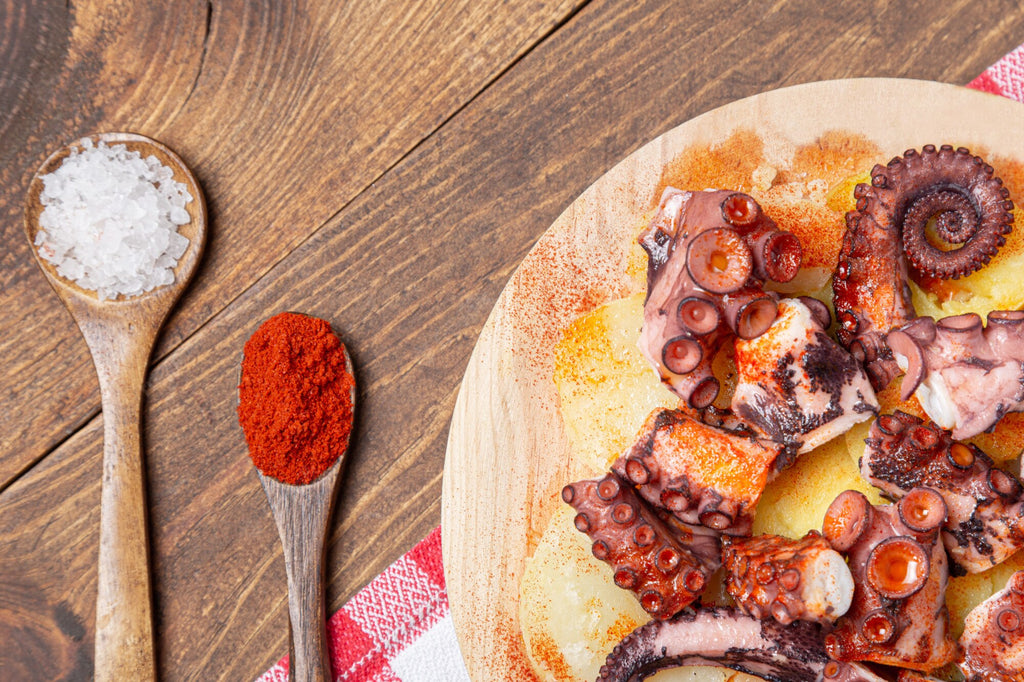Today we have Julio, a chef from Galicia, to bring us the authentic recipe for Galician octopus in a pressure cooker (or pulpo á feira , as they say in Galicia). There's no one better than him to tell us how to make the traditional recipe!
Julio gives us some of the tricks to make it perfect, from showing us how to scare it so it doesn't peel, to considerations such as not putting salt or bay leaves in the water if we want to do it right. We obviously accompany the octopus with boiled potatoes, and make sure they are nice and red with paprika!
A good octopus made in a moment thanks to the WMF Perfect pressure cooker. We prepared it in the largest pot, the 8.5L one (you can see it here individually or together with the 4.5L body ), although you can make it perfectly the same in the more common 6.5L set .

Ingredients (for 8 servings with 8.5 L pot)
- 1 frozen octopus weighing 2.5 kg
- 1.5 kg of potatoes for cooking
- Quality paprika
- Extra virgin olive oil
- Flower of salt
Preparation
- Defrost the octopus in plenty of water (NOT HOT).
- Pour 5 liters of water into the WMF pressure cooker and put it on maximum heat until it starts to boil WITHOUT SALT.
- Meanwhile, clean the suckers and tentacles well and remove the mouth or beak from the center under the head.
- Peel the potatoes and cut them into large pieces
- When the water in the pot starts to boil, put the octopus in and leave it in the boiling water for 1 minute, take it out, keep it out for 1 minute and start again, 1 minute boiling and 1 minute out. Repeat this operation 3 times, on the fourth leave it in the water and close the lid of the pressure cooker and continue with the heat at maximum, when the valve has risen to the second ring, lower the heat and cook on the second ring above for 7 minutes.
- Let it depressurize without forcing it so that the lid comes off easily. Remove the octopus and set aside in a container, also pouring in 3/4 of the hot cooking water. Cover it so that it does not cool down.
- With the rest of the cooking water in the pot, add the potatoes; close the pot again and put the heat on maximum; when the valve has risen to the second ring, lower the heat and cook on the second ring above for 3 minutes.
- While the potatoes are cooking, cut the octopus into bite-sized pieces.
- Allow the pot to depressurize without forcing it until the lid comes off easily.
- Remove the potatoes from the water and drain them; place them next to the already cut octopus and season everything in this order: sprinkle with paprika, then salt and finally drizzle generously with olive oil.

























Comments
Claudia&Julia said:
Hola Alberto,
Muchas gracias por la explicación de las diferencias entre ambos. Nos quedamos con ella ;)
¡Un saludo!
Claudia&Julia said:
Hola E. Souto,
Tal como lo explicas, seguro que debe estar delicioso ;)
¡Un saludo!
E. Souto said:
El pulpo a feira, en las ferias de ganado de Galicia, se come con pan de petada (hogaza), nunca con cachelos, invención de los restaurantes para poner menos pulpo y ¡cobrar las patatas a precio de pulpo!
Concepcion said:
En la olla se ven rodajas de limón y laurel. Cuando se le ponen?, o es para la fotito?
Alberto said:
Muy buenas!! Unas recetas estupendas y super sabrosas. En este caso el pulpo a feira es un pulpo que se prepara únicamente con aceite, pimentón y sal, y la forma de cocción es directa.
En el pulpo a la gallega se tiene que “asustar” al pulpo en su cocción y se introducen los cachelos como mayor diferencia entre ambos. Un saludo!!!
Cecilia said:
He preparado hoy la receta para mi familia, nunca había cocinado pulpo y ha quedado estupenda. Muchas gracias por compartirla!